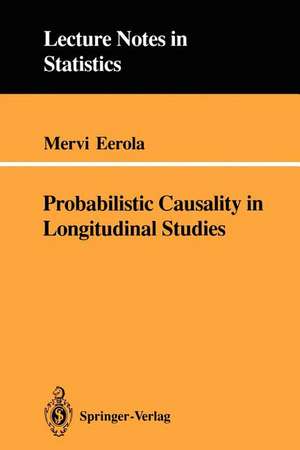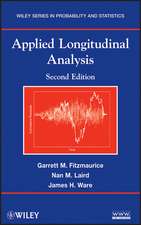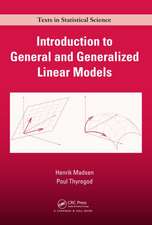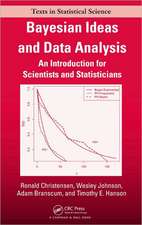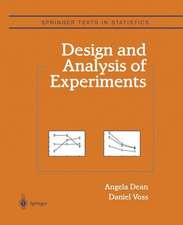Probabilistic Causality in Longitudinal Studies: Lecture Notes in Statistics, cartea 92
Autor Mervi Eerolaen Limba Engleză Paperback – 7 oct 1994
The proposed prediction method in this study provides a framework to study the dynamics and the magnitudes of causal effects in a series of dependent events. Its usefulness is demonstrated by the analysis of two examples both drawn from biomedicine, one on bone marrow transplants and one on mental hospitalization.
Consequently, statistical researchers and other scientists concerned with identifying causal relationships will find this an interesting and new approach to this problem.
Din seria Lecture Notes in Statistics
- 15%
 Preț: 631.86 lei
Preț: 631.86 lei - 17%
 Preț: 490.19 lei
Preț: 490.19 lei - 17%
 Preț: 460.28 lei
Preț: 460.28 lei - 18%
 Preț: 945.92 lei
Preț: 945.92 lei - 18%
 Preț: 1007.35 lei
Preț: 1007.35 lei - 18%
 Preț: 1231.47 lei
Preț: 1231.47 lei -
 Preț: 383.33 lei
Preț: 383.33 lei - 15%
 Preț: 640.71 lei
Preț: 640.71 lei - 15%
 Preț: 658.88 lei
Preț: 658.88 lei -
 Preț: 436.14 lei
Preț: 436.14 lei - 20%
 Preț: 561.42 lei
Preț: 561.42 lei - 15%
 Preț: 639.59 lei
Preț: 639.59 lei - 15%
 Preț: 633.53 lei
Preț: 633.53 lei - 18%
 Preț: 943.25 lei
Preț: 943.25 lei - 15%
 Preț: 641.38 lei
Preț: 641.38 lei - 18%
 Preț: 995.97 lei
Preț: 995.97 lei - 18%
 Preț: 943.25 lei
Preț: 943.25 lei - 15%
 Preț: 643.00 lei
Preț: 643.00 lei - 18%
 Preț: 947.18 lei
Preț: 947.18 lei - 18%
 Preț: 942.63 lei
Preț: 942.63 lei - 18%
 Preț: 886.62 lei
Preț: 886.62 lei -
 Preț: 383.12 lei
Preț: 383.12 lei - 15%
 Preț: 633.35 lei
Preț: 633.35 lei - 15%
 Preț: 635.65 lei
Preț: 635.65 lei -
 Preț: 393.74 lei
Preț: 393.74 lei - 15%
 Preț: 632.70 lei
Preț: 632.70 lei - 15%
 Preț: 637.28 lei
Preț: 637.28 lei - 15%
 Preț: 702.87 lei
Preț: 702.87 lei - 15%
 Preț: 642.68 lei
Preț: 642.68 lei - 15%
 Preț: 644.63 lei
Preț: 644.63 lei - 15%
 Preț: 645.14 lei
Preț: 645.14 lei -
 Preț: 382.36 lei
Preț: 382.36 lei - 15%
 Preț: 636.30 lei
Preț: 636.30 lei - 15%
 Preț: 647.92 lei
Preț: 647.92 lei -
 Preț: 380.63 lei
Preț: 380.63 lei - 18%
 Preț: 887.05 lei
Preț: 887.05 lei - 15%
 Preț: 634.32 lei
Preț: 634.32 lei - 15%
 Preț: 648.74 lei
Preț: 648.74 lei -
 Preț: 378.92 lei
Preț: 378.92 lei - 15%
 Preț: 648.56 lei
Preț: 648.56 lei - 15%
 Preț: 647.59 lei
Preț: 647.59 lei - 18%
 Preț: 780.37 lei
Preț: 780.37 lei - 15%
 Preț: 641.20 lei
Preț: 641.20 lei - 18%
 Preț: 1102.69 lei
Preț: 1102.69 lei - 15%
 Preț: 643.16 lei
Preț: 643.16 lei -
 Preț: 384.70 lei
Preț: 384.70 lei - 15%
 Preț: 640.37 lei
Preț: 640.37 lei
Preț: 379.68 lei
Nou
Puncte Express: 570
Preț estimativ în valută:
72.66€ • 74.96$ • 61.50£
72.66€ • 74.96$ • 61.50£
Carte tipărită la comandă
Livrare economică 04-18 martie
Preluare comenzi: 021 569.72.76
Specificații
ISBN-13: 9780387943671
ISBN-10: 0387943676
Pagini: 131
Ilustrații: VIII, 131 p.
Dimensiuni: 155 x 235 x 8 mm
Greutate: 0.22 kg
Ediția:Softcover reprint of the original 1st ed. 1994
Editura: Springer
Colecția Springer
Seria Lecture Notes in Statistics
Locul publicării:New York, NY, United States
ISBN-10: 0387943676
Pagini: 131
Ilustrații: VIII, 131 p.
Dimensiuni: 155 x 235 x 8 mm
Greutate: 0.22 kg
Ediția:Softcover reprint of the original 1st ed. 1994
Editura: Springer
Colecția Springer
Seria Lecture Notes in Statistics
Locul publicării:New York, NY, United States
Public țintă
ResearchCuprins
1. Foundations of Probabilistic Causality.- 1.1 Introduction.- 1.2 Historical aspects of causality.- 1.3 Probabilistic causality.- 1.4 Different interpretations of probability in causality.- 1.5 Counterfactuals in causality.- 1.6 Causality in statistical analysis.- 1.7 Discussion.- 2. Predictive Causal Inference in a Series of Events.- 2.1 Introduction.- 2.2 The mathematical framework: marked point processes.- 2.3 The prediction process associated with a marked point process.- 2.4 A hypothetical example of cumulating causes.- 2.5 Causal transmission in terms of the prediction process.- 3. Confidence Statements About the Prediction Process.- 3.1 Introduction.- 3.2 Prediction probabilities in the logistic regression model.- 3.3 Confidence limits for ?t using the delta-method.- 3.4 Confidence limits for ?t fit based on the monotonicity of hazards.- 3.5 Discussion.- 4. Applications.- 4.1 Multistate models in follow-up studies.- 4.2 Modelling dependence between causal events.- 4.3 Two applications.- 4.4 Sensitivity of the innovation gains on hazard specification.- 4.5 Discussion.- 4.6 Computations.- 4.7 Further uses of the method.- 5. Concluding Remarks.- Appendices 1–2.
